Environmental Issues – CBSE Notes for Class 12 Biology
NCERT Solutions Maths Physics Chemistry Biology Science
Pollution, Solid and Radioactive Wastes:
1. Pollution
is an undesirable change’in the physical, chemical and biological characteristics of air, water, land and soil.
(i) Pollutants are agents that cause undesirable change in the environment.
(ii) The Government of India has passed the Environment Protection Act, 1986 to protect and improve the quality of our environment (air, water and soil).
2. Air pollution
occurs due to undesirable change in the physical, chemical and biological characteristics of air that exerts harmful effects on human beings.
(i) Causes of Air Pollution
(a) Smoke stacks from thermal power plants, forest fires, volcanic eruptions, etc.
(b) Garbage decomposition also releases unwanted gases in the air.
(c) Excessive use of fossil fuels by automobiles and industries release particulate and air pollutants.
(d) Use of leaded petrol.
(ii) Types of Air Pollutants
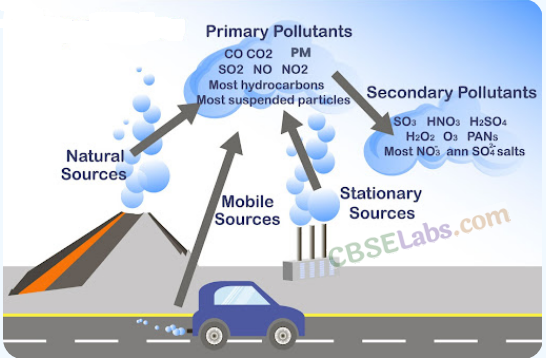
(iii) Harmful Effects of Air Pollution on Health
(a) Carbon monoxide (CO) causes giddiness, headache, cardiovascular malfunction, asphyxia, etc.
(b) Hydrogen sulphide (H
2
S) causes nausea, eye and throat irritation.
(c) Sulphur dioxide (SO
2
) causes respiratory tract diseases like asthma, bronchitis, cancer, emphysema, etc.
(d) Fine particulates released by industries cause breathing and respiratory problems, inflammation and damage to the lungs.
(e) In plants reduced growth and yield and premature death occurs.
(iv) Control Methods of Air Pollution
There are several methods used for controlling air pollution in India.
These are:
(a) Electrostatic Precipitator (ESP) is an electrical device to remove particulate matter present in the exhaust of thermal power plant.
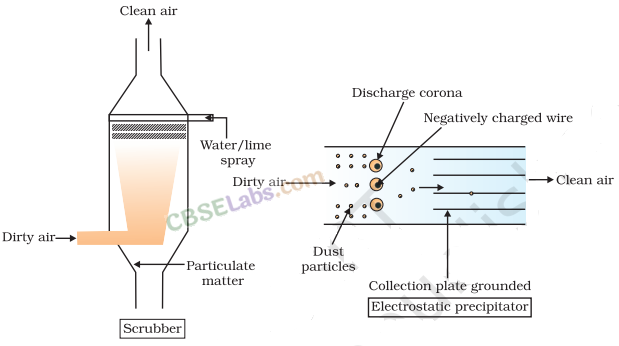
• About 99% of particulate matter can be removed by ESP.
• It has electrode wires and a stage of collecting plates.
• Electrode wires are provided with an electric current of several thousand volts, which produces a corona that releases electrons.
Discharged corona Negatively charged wire
• These electrons get attach to the dust Electrostatic precipitator
particles and give them negative
charge within a small fraction of a second.
• Collecting plates are grounded that attract the charged dust particles.
• The velocity of air between the plates must be low enough to allow the dust to fall.
(b) Scrubber is used to remove harmful gases like sulphur dioxide from industrial
exhaust.
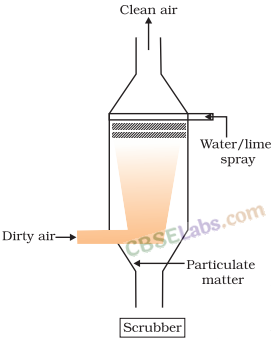
The exhaust is passed through a spray of water or lime.
• Water dissolves the gases and lime reacts with sulphur dioxide to form a precipitate of calcium sulphate and sulphide.
* Drawbacks Recently, the dangers of particulate matter that are very small and cannot be removed by these precipitators has been found. According to Central Pollution Control Board (CPCB), particulate size 2.5 micrometers or less in diameter (PM 2.5) if inhaled can cause breathing and respiratory problems, irritation, damage to lungs and premature deaths.
(c) Catalytic convertors are fitted into automobiles for
reducing emission of poisonous gases like NO
2
and CO.
• They are made of expensive metals like platinum, palladium and rhodium as catalysts.
• When exhaust passes through the catalytic convertor, nitric oxide splits into nitrogen and oxygen; carbon monoxide is oxidised into carbon dioxide and unburnt hydrocarbons get burnt completely into CO
2
and H
2
O.
• Unleaded petrol should be used in motor vehicles fitted with catalytic convertor as leaded petrol inactivates the catalyst.
(i) A Case Study— Control of Air Pollution in Delhi
(a) Delhi leads the country in high levels of air pollution due to large numbers of vehicles. In 1990s, Delhi ranked fourth among the 41 most polluted cities of the world.
(b) As per directives of Supreme Court, all buses of Delhi were converted to run on Compressed Natural Gas (CNG) by the end of 2002.
(c) Benefits of CNG over diesel/petrol
* Burns most efficiently and leaves no unburnt remains.
– Cheaper than diesel/petrol.
* Cannot be siphoned off by thieves and adulterated like petrol or diesel.
(d) Other ways to reduce vehicular pollution
* Phasing out of old vehicles.
* Use of unleaded petrol.
* Use of low-sulphur petrol and diesel.
* Application of stringent pollution-level norms for vehicles.
* Use of catalytic convertors in vehicles.
(vi) Auto Fuel Policy of Government of India
(a) Euro II norms stipulate that sulphur be controlled at 350 parts per million (ppm) in diesel and 150 ppm in petrol. Aromatic hydrocarbons are to be contained at 42% of the concerned fuel.
(b) According to it, all automobiles have to meet the Euro III emission specification in eleven Indian cities by 1 April, 2005.
(c) The same eleven cities have to meet the Euro IV norms by 1 April, 2010.
(d) The rest of the country will have Euro III emission norm compliant automobiles and fuels by 2010.
(e) By all these efforts, a substantial fall in CO
2
and SO
2
level has been found in Delhi between 1997 and 2005.
3. Noise pollution
is undesirable high level of sound. In India, the Air (Prevention and Control of Pollution) Act came into force in 1881, but was amended in 1987 to includes noise as art air pollutant.
Noise measurement Sound is expressed in decibels (dB). A sound of over 115 dB is very harmful for ears. Prolonged exposure to noise level above 80 dB leads to perma nent hearing loss.
(i) Causes are
(a) Use of loudspeakers and music systems. (b) Jet planes and rockets take-off.
(c) Industrial, factory noises, etc.
(ii) Harmful effects are sleeplessness, stress, increased heartbeat, breathing problems, damage to ear drums and impaired hearing ability.
(iii) Control Methods
(a) By applying sound-absorbent materials or by muffling noise in industrial units.
(b) Delimitation of horn-free zones around hospitals and schools.
(c) Strict laws for permissible sound levels of crackers and loudspeakers should be followed.
(d) Loudspeakers should be played up to a fixed time only.
4. Water pollution
is any undesirable change in the physical, chemical or biological properties of water that may affect the human beings and aquatic species.
(ii) The Government of India has passed the Water (Prevention and Control of Pollution) Act, 1974 to safeguard our water resources.
(ii) Sources of Water Pollution
(a) Domestic sewage includes everything that comes from residential area to common public sewage system. A mere 0.1% impurities make domestic sewage unfit for human use.
Composition of domestic sewage
* Suspended solids, e.g. sand, silt and clay.
* Colloidal material, e.g. faecal matter, bacteria, cloth and paper fibres.
* Dissolved materials, e.g. nutrients (nitrate, ammonia, phosphate, sodium and calcium).
* It mainly contains biodegradable organic wastes, which are readily decomposed with the help of decomposers.
(b) Industrial wastes are released by petroleum, paper manufacturing, metal • It contains heavy metals like mercury and many organic compounds.
(iii) Effects of Water Pollution
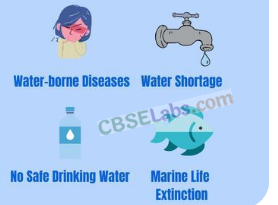
(a) Biological magnification can be defined as the increase in concentration of toxicants at successive trophic levels.
• Mercury and DDT are well known for biological magnification.
• Toxic materials cannot be metabolised or excreted. Therefore, they get accumulated in an organism and pass on to higher trophic levels.
• DDT accumulates in birds and disturbs calcium metabolism, which results in thinning of egg shell. This results in decline of bird population.
(b) Eutrophication can be defined as the natural ageing of a lake by nutrient enrichment of its water.
Process of Eutrophication
• Water in young lake is cold and clear to support life.
• Gradually with time, it gets enriched with nutrients as nitrogen and phosphorus by streams draining in it.
• Due to this, aquatic life (plants and animals) flourish in lake.
• Organic remains deposit at the bottom of the lake and with time, water becomes warmer.
Eventually, floating plants develop in the lake, finally converting it into land. This accelerated ageing of lakes due to sewage, agricultural and industrial wastes is called cultural or accelerated eutrophication.
(c) Biochemical Oxygen Demand (BOD) is the amount of oxygen required for microbial breakdown of biodegradable organic matter. It is higher in polluted water and lesser in clean water.
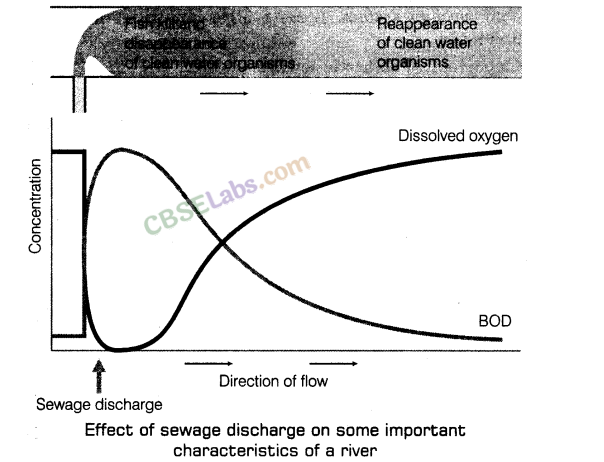
(d) Algal bloom is excessive growth of planktonic (free-floating) algae in aquatic bodies.
• In domestic sewage, nutrients like nitrogen and phosphorus favours the growth of algal bloom.
• It causes fish mortality and deterioration of water quality.
Example, Excessive growth of water hyacinth (Eichhornia crassipes). It is the most problematic aquatic weed, also called Terror of Bengal.
It grows abundantly in eutrophic water bodies and imbalances water ecosystem.
(vi) A Case Study— Integrated Wastewater Management
(a) Wastewater including sewage can be treated in an integrated manner by utilising a mix of artificial and natural processes.
• One such example is town of Areata situated along Northern coast of California. An integrated wastewater treatment process was developed with the help of biologists from Humboldt State University in this town.
• The cleaning occurs in two steps:
— The conventional sedimention, filtrating and chlorine treatment is carried out.
The treated water still contain lots of heavy metals and other toxic pollutants.
– In second step, algae, fungi and bacteria are grown in marsh land through which water flowed. These life forms neutralise, absorb and assimilate the pollutants and purify the water naturally.
The marshes also constitute a sanctuary, with a high level of biodiversity.
(b) Ecosan toilets have been developed in areas of Kerala and Sri Lanka for ecological sanitation. The advantages of ecological sanitation are:
• A practical, hygienic and efficient method of disposal.
• Cost effective approach.
• Human excreta can be recycled into natural fertiliser to reduce need of chemical fertiliser.
5. Solid wastes
refer to everything that goes out in trash. The various types are:
(i) Municipal solid wastes contain wastes from homes, offices, schools, hospitals, etc., that are collected and disposed by the municipality, which generally consists of paper, leather, textile, rubber and glass, metals and plastic, etc.
(ii) Industrial wastes contain wastes like scraps, fly ash, etc., generated by industries.
(Hi) Hospital wastes contain disinfectants and other harmful chemicals generated by
hospitals.
(iv) Electronic wastes (e-wastes) are the damaged electronic goods and irreparable computers.
(a) Methods of Solid Waste Disposal
There are various methods of solid waste disposal. Some of them are:
• Open burning involves burning of municipal waste in open dumps but the unburnt piled waste serves as breeding ground for rats and flies.
• Sanitary landfills are areas where wastes are dumped in a depression or trench after compaction and covered with dirt. The problem is seepage of chemicals from these landfills can pollute underground water resources.
• Rag-pickers and kabadiwallas collect and separate out wastes into reusable or recyclable categories.
• Natural breakdown involves dumping biodegradable materials into deep pits for natural degradation.
• Incineration is a method of hospital waste disposal.
• E-Wastes
– E-wastes are buried in landfills or in ~inerated.
– About half of the e-wastes generated in the developed world are exported to developing countries, mainly to China, India and Pakistan, where metals like copper, iron, silicon, nickel and gold are recovered during recycling process.
– Developed countries have specifically built facilities for recycling of e-wastes.
– Recycling is only solution available for treating e-waste but caution should be taken to carry out process environment friendly.
(b) A Case Study — Remedy for Plastic Waste
• A plastic sack manufacturer, Ahmad Khan from Bengaluru realised that plastic waste was a real problem.
His company developed a fine powder, called polyblend of recycled modified plastic.
• This mixture is mixed with the bitumen and used to lay roads.
• It enhanced the bitumen’s water repellant properties and helped to increase road life by a factor of three.
• Using this technique, by the year 2002, more than 40 kms of road in Bengaluru has already been laid.
6. Soil pollution
is any undesirable change in soil profile affecting its productivity.
(i) Green revolution led to manifold increase in crop production by the use of inorganic fertilisers and pesticides.
(ii) Pesticides, herbicides, fungicides, etc., are being increasingly used afterwards which resulted in so’l pollution.
(iii) Causes of Soil Pollution
(a) Chemical seepage from industries.
(b) Excessive use of inorganic fertilisers, pesticides, etc.
(iv) Harmful Effects of Soil Pollution
(a) Non-target organisms are killed in the soil.
(b) Soil becomes unfertile.
(c) Pesticides can result in biomagnification.
(vi) Control Methods
(a) Strict ways should be adopted by the industries and other sources for waste disposal.
(b) Use of organic farming It is a cyclical, zero-waste method, where waste products from one process are cycled in as nutrients for other processes, allowing maximum utilisation of resources and increasing the efficiency of production.
(ini) A Case Study— Organic Fanning
(a) Ramesh Chandra Dagar, a farmer in Sonipat (Haryana) included bee-keeping, dairy management, water harvesting, composting and agriculture in a chain of processes.
(b) This chain supports each other and allow an extremely economical and sustainable venture.
(c) Chemical fertilisers are not required as cattle excreta is used as manure.
(d) Crop waste is used for making compost, which is used as natural fertiliser or to generate natural gas, which is used for satisfying energy needs of farm.
(e) To spread information and help the practice of integrated organic farming. Dagar has created the Haryana Kisan Welfare club, with current membership of
5000 farmers.
7. Radioactive wastes
include nuclear waste, which is given off as radiation.
(i) Nuclear energy was initially considered as a non-polluting way for generating electricity initially.
(ii) Later, two serious inherent problems were realised. The first is accidental leakages as occurred in the Three Mile Island and Chernobyl, which proved that radioactive wastes are most potent pollutants. The second is safe disposal of radioactive wastes.
(iii) Harmful Effects
(a) Radiations causes mutation at a very high rate.
(b) At high doses, nuclear radiations are lethal.
(c) At low doses, these cause disorders and diseases like cancer.
(iv) Disposal method of radioactive wastes involve pretreatment and storage in shielded containers and then burying at about 500m deep below the earth’s surface. However, this method of disposal is getting opposition from public.
CBSE Notes CBSE Notes Biology NCERT Solutions Biology